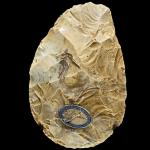Stone Age Groups Made Similar Toolmaking Breakthroughs

Different palaeolithic populations around the world might have developed a crucial toolmaking skill independently. This conclusion, based on the analysis of hundreds of artefacts from a recently excavated archaeological site in Armenia, weakens a long-held theory that Stone Age people in Eurasia learnt sophisticated techniques from migrating African tribes. The work is published in Science1.
Discovered in 2008, the Nor Geghi site fills a significant gap in the fossil record of the Caucasus region, which prehistoric African populations might have crossed en route to Eurasia. “The finds from Nor Geghi are critical because they provide a quality of data that we have been missing,” says Christian Tryon, a palaeolithic archaeologist at Harvard University in Cambridge, Massachusetts, who was not involved in the study.
Early Stone Age populations made their tools much in the same way that Michelangelo would have made his David — by chipping away at a piece of stone until the required shape emerged. Such tools are known as bifacial.
In the so-called Levallois technology, named after the Levallois-Perret suburb of Paris where it was first described, the toolmaker first chisels a suitably shaped core from a stone and then slices off flakes from it. The flakes are the tools — lighter to carry, and probably more efficient to make.
Chipping away at the truth
In the 1990s, archaeologists proposed2 that the Levallois method first evolved in Africa, and that it became widespread after a group of hominids migrated to Europe and Asia and carried it with them. The hypothesis sought to explain why stone tools made by the Levallois method apparently appeared earlier in Africa than in other parts of the world. It assumed that the superior method would quickly replace the simpler bifacial technique that had been used for the previous million years.
But the idea was controversial because it invoked an unproven migration of unknown hominids out of Africa, and did not explain why some Levallois tools found in Eurasia are smaller, or otherwise different, from African ones. It also relied on uncertain fossil dating.
The latest research, led by palaeolithic archaeologist Daniel Adler at the University of Connecticut in Storrs, is based on an excavation at Nor Geghi between 2008 and 2009. Then came years of analysis.
The site is particularly well preserved. Flood plain sediment with volcanic ash is trapped between two lava flows dated to 200,000 and 400,000 years ago — the era in which the earliest Levallois tools had been found in Africa.
The scientists were able to date the volcanic ash, and this guided them to the dates of the nearby artefacts.
Using chemical analysis they were also able to work out that the obsidian (a type of volcanic rock) that the Stone Agers used for tools came, in part, from various local sources, but also from sources up to 120 kilometres away. But the team was particularly surprised to find a mixture of tools made using both technologies.
“We wouldn’t have found this mixture if the Levallois technology had simply replaced the old method,” says Adler. “The communities probably worked out for themselves how to make bifacial tools and then it was a short step to the Levallois method.” He argues that the Stone Age people used both approaches flexibly.
Many palaeontologists have argued that it would have been intuitive for Stone Agers to evolve their bifacial technology — but until now they had no evidence to back up their hunch.
- Nature
- doi:10.1038/nature.2014.16002
